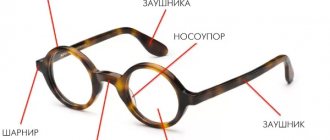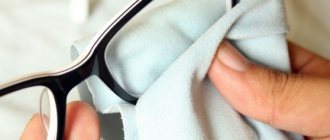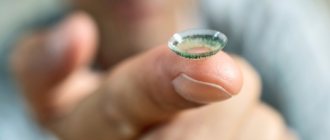How do photochromic glasses work?
Chameleon glasses do not react to bright light, but to ultraviolet radiation.
This means that they will become dark outdoors, but at the same time, if the sun shines on the office at work or the interior of the car, lenses with photochrome will remain transparent. How is this effect achieved? The secret is in the molecules of photochromic substances. Under the influence of ultraviolet radiation, they change their structure and stop transmitting light. As a result, photochromic glasses darken. As soon as the UV radiation disappears, the structure of the substances changes again.
Today, there are several technologies for producing lenses with variable light transmission.
- Application of photochromic coating. A thin layer of photochromic particles is applied to the surface of the lens, providing darkening. This method is currently considered obsolete, since the degree of light absorption is not high enough, and the darkening and lightening time is long.
- Introduction of photochromic agents into the material. They impregnate ready-made lenses. The most famous brand is Transitions.
- Volume-distributed technology. The bottom line is that photochromic molecules are evenly distributed throughout the lens material during its manufacture. Such optical products are produced by SunSensors.
What glasses use photochromic lenses?
The main advantage of the photochromic coating on glasses is that it can be applied to lenses with diopters. In this way, it is possible to relieve people with refractive errors from the need to carry several models with them. There are no restrictions on the refractive index, surface shape, or number of optical zones.
Photochromic sunglasses are also quite popular. For example, the Serengeti company produces ultra-light models with polarizing, oleophobic, hydrophobic coatings and anti-fog, which are suitable for lovers of an active lifestyle.
What colors are photochromic lenses? The most popular options are those that provide eye comfort in any lighting. These are brown, gray and green shades of varying intensities. However, today you can find brighter options: for example, Transitions Signature lenses are available in emerald, sapphire, amethyst and amber colors. Here's what women's and men's glasses with such photochromic lenses look like in the photo:
Who are photochromic lenses recommended for?
Chameleons without diopters are suitable for people involved in tourism or skiing
. Since the terrain and lighting of mountain ranges are constantly changing, quick adjustment of the eyes is necessary. With photochromic lenses it is painless, and image clarity does not suffer during a sharp transition from a darker area to a sunny one and vice versa.
Chameleons will also be a useful acquisition for cyclists
. Fitting tightly to the face, they will protect the eyes not only from bright light, but also from dust and insects.
Chameleon glasses without diopters are also used by drivers
. The darkness of the lenses in this segment is 50%. And when photochromic lenses are coated with a polarizing anti-reflective coating, the optics provide even greater safety on the road. The driver's eyes will be protected from the shine of wet asphalt, objects that glow in the dark, and other blinding interference at any time of the day.
Ophthalmologists recommend corrective photochromic glasses to all patients, but especially in such cases:
● recent eye surgery;
● presence of retinal pathologies;
● farsightedness in old age;
● predisposition to cataracts in adulthood;
● high photosensitivity.
Types of photochromic lenses for glasses with diopters
Photochromic lenses with diopters are needed to obtain sun protection with a corrective effect. Corrective optics are divided into:
● traditional;
● monofocal;
● progressive;
● aspherical.
Monofocal and traditional lenses are prescribed for farsightedness and myopia
. A mild form of astigmatism requires wearing aspherical lenses. For age-related changes in vision, doctors recommend the progressive type.
Rating of photochromic lenses for glasses with diopters
Photochromic lenses developed using the following technologies are considered the best:
1. Transitions.
Such lenses transmit light in full indoors. In daylight outside, the windows quickly darken.
2. Serengeti Polar.
Their main feature is the polarizing coating. Absorbs up to 95% of harmful blue radiation and up to 100% of ultraviolet radiation. This is the most optimal option for corrective lenses.
3. SunSensors.
Photochromes are embedded in a liquid polymer rather than applied to the finished lens by sputtering. Light absorption capacity reaches 100%. Lenses made using this technology are the most popular in Russia.
Features of use
Now that we have figured out what photochromic lenses mean, let's talk about their features. At first glance, it seems that such optical products are the best choice for any person. They provide comfort both indoors and outdoors, while a person does not have to make any effort to see clearly.
However, photochromic glasses for glasses have their own nuances of use.
- Lenses do not darken or lighten instantly. This is one of the main indicators that you are advised to pay attention to when ordering glasses. On average, the time required for photochromic cells to react is between 30 seconds and 5 minutes. It should be noted that the lens color begins to change immediately, i.e. You won't find yourself in a situation where the glasses remain completely black indoors. The smooth change in light transmittance is comfortable for the eyes, so buyers usually do not complain about this feature.
- Lenses may darken and lighten unevenly. There are two reasons why this happens. For products manufactured using the volumetric method, photochromic molecules are randomly incorporated into the material, and there may be fewer of them in some places than in others. The second reason is the different thickness of the lenses in the center and on the periphery for myopia and hypermetropia. When darkening, areas of different colors will remain.
- The degree and speed of darkening depend on the ambient temperature. The reaction occurs faster in warm weather and slower in cold weather. At temperatures above 30 °C, the lenses do not darken completely, but by 90-95%, which can cause discomfort to residents of the southern regions. In the cold, on the contrary, the glasses give out their maximum, which is not always convenient during partly cloudy weather or a walk through the forest with constantly changing lighting.
- The service life of photochromic lenses is from 2 to 5 years. Gradually, the resource is exhausted under the influence of UV radiation and light absorption indicators deteriorate. However, it should be noted here that, firstly, manufacturers are constantly working to increase the service life of lenses, and secondly, ophthalmologists recommend that people with refractive errors undergo vision tests and, if necessary, change glasses every 2-3 years.
Personal eye protection
Safety glasses OF and OPF designed to protect eyes from burn injuries and reduce the duration of adaptive blinding when personnel operate outside shelters.Glasses are put on in advance and worn constantly in conditions of threat of enemy use of nuclear weapons.
The glasses are designed for repeated use to protect the eyes. When infected with toxic substances, radioactive dust, or bacteriological agents, glasses are subjected to special treatment.
Anti-burn glasses in OPF case . Special OFF glasses to protect a soldier’s eyes from light, IR and UV radiation of a nuclear explosion with Chameleon technology
Light filters easily transmit light of normal intensity, but instantly darken when exposed to powerful light. The protection effect is achieved by absorbing the energy of the light pulse with a photochromic and infrared light filter.
It is permissible to wear goggles over the front parts of gas masks.
The disadvantages of ZIZG are:
- safety glasses limit the field of view;
- the presence of color filters in the block may cause a slight distortion in the perception of weak color signals;
- changing the optical-geometric characteristics of the light flux by a block of light filters leads to a decrease in the functionality of the eyes and to some limitation of the professional activities of personnel at dusk and especially at night.
These shortcomings can be corrected by training personnel in order to develop stable indicators of professional activity using points for necessity.
Selection of glasses and preparation for work in them. When receiving glasses for use, you must: check the completeness; visually check the integrity of the filters and other components of the glasses; remove talc by wiping the body and headband with a swab moistened with water; Wipe the light filters with a clean cloth; remove the clamping rings, install anti-fog NPN films and secure them with clamping rings; adjust the length of the headband tapes so as to ensure a tight fit of the body, eliminate wrinkles and direct light into the sub-head space.
The anti-fog layer on the films is applied on both sides, so you can install them in glasses with either side facing the filters. If necessary, moistened but uncontaminated NPN films can be used several times. To do this, after removing the glasses, the anti-fog films must be dried without wiping or removing them from the glasses.
Store glasses prepared for use in a case. To put the glasses in the case you need to: fold the glasses, to do this, assemble the headband and place it together with the headphones on the back of the glasses case; put the glasses into the case with the light filters facing the outer wall of the case; insert boxes of anti-fog films to the left and right of the glasses; put a napkin and passport into the lid of the case; close the lid and fasten the strap.
The case protects the glasses from deformation and damage. The case is made of polyethylene and has a holder with which it can be worn on a waist belt.
Glasses can be worn by personnel in the “traveling” and “combat” positions. In the “stowed” position, the glasses are placed in a case. If there is a threat of the enemy using nuclear weapons, at the command “Put on protective equipment in the “atom” position” or independently, the glasses should be switched to the “combat” position and constantly worn when personnel are operating in open areas.
To transfer the glasses to the “combat” position you must:
- remove the steel helmet and headdress;
- if necessary, wear a respirator (when operating in areas contaminated with RP);
- take the glasses out of the case and, without touching the filter glasses with your fingers, put them on your head;
- check the tight fit of the glasses body to the face;
- put on a hat so that when the head is straight, the visor is at eye level;
- lower and fasten the headphones of the headdress under the chin with a button;
- fasten the curtains of the headdress with two buttons in front of the face;
- wear a steel helmet.
When using a noise-protecting helmet, glasses should be worn over the helmet.
Glasses are removed by the command “Remove protective glasses” when entering enclosed spaces or weapons and military equipment facilities, as well as in the absence of a threat of the enemy using nuclear weapons.
To remove glasses you must:
- remove the steel helmet,
- unfasten the buttons on the curtains of the OKZK headdress (OKZK-M, OKZK-D);
- remove the headdress;
- grasp the body of the glasses with your fingers, slightly pull the glasses forward and carefully remove them from your head with an upward movement;
- dry the anti-fog films or replace them if necessary;
- put the glasses in the case,
- fasten the strap.
When entering a warm room and your glasses become foggy, wipe them with a dry cloth.
dried before placing them in the case .
In winter conditions, to maintain the elasticity of the rubber parts (case, headband), it is recommended to place them over the side of your overcoat or jacket before using the glasses for their intended purpose.
In conditions of sudden use by the enemy of chemical or bacteriological (biological) weapons, protective glasses are removed when the protective equipment is switched to the “gases” position from the “atom” position.
If necessary, it is allowed to use goggles in the “combat” position over the front parts of gas masks.
Glasses contaminated with droplet liquid 0B, RP, BA are subjected to special treatment. When treating glasses with degassing, decontaminating, disinfecting solutions, do not allow them to penetrate between the glasses of the light filter unit, for which use moistened swabs.
After processing, wipe the filter block with a clean, dry swab (napkin).
Glasses must be protected from prolonged exposure to moisture, abrasive materials, shocks and falls. Scratches and cracking of the surface of the filters reduce the protective properties of the glasses and reduce visibility. Performance characteristics of protective glasses
| OF | ||
| Relaxation time | 10-45 sec | 0.2 sec |
| Energy attenuation coefficient | 15-30 | 15-30 |
| Light transmission in the initial state | 67 % | 72% |
| Weight of points | 480 g | 500 g |
Classification of photochromic lenses for glasses
The main characteristic of photochromic lenses is the degree of darkness. This parameter is denoted by the abbreviation VLT - Visible Light Transmission. The higher the percentage of light transmission, the more transparent the lens appears. Thus, glasses with an S0 value transmit from 80 to 100% of light; they are worn indoors - for example, they are used for computer glasses. The maximum value is S4. Such lenses are used by climbers or residents of settlements located high in the mountains: optical products transmit only 3-8% of visible light.
For a comfortable life in the city, glasses with a light transmittance index of S2-S3 are enough: this is enough to feel comfortable in the bright sun, at dusk, and in partly cloudy weather. For photochromic prescription glasses, the VLT usually starts at S0 (90-95% of visible study is missed) and goes up to S3 (10-15% is missed).
Photochromic glasses can have lenses made of glass and plastic. It is important to note that specially developed complex composite materials such as Trivex are used to produce optical products today, so polymer lenses are very different for the better from those that were in use 20-30 years ago. We have listed the key pros and cons of each option in the table.
| Advantages | Flaws | |
| Plastic lenses | Minimum weight. Glasses are practically not felt on the face, so they are well suited for vision correction. In addition, they look more elegant. Low risk of injury. If plastic lenses break, they will become covered with a network of cracks, but will not shatter into small fragments. Plastic lenses are recommended for children and people leading an active lifestyle. Possibility of producing lenses with double curvature at an affordable price. | Fragility. In terms of average service life, plastic lenses are inferior to glass ones. In order for plastic lenses not to harm the eyes and to be durable, they must be made of modern materials and covered with several protective layers. You need to buy lenses from trusted brands and in stores that are an official representative or are ready to give a guarantee. |
| Glass lenses | Suitable for correcting severe cases of myopia and farsightedness. Not exposed to high and low temperatures. They have “built-in” UV protection. | Discomfort. Due to the heavy weight, the glasses put pressure on the bridge of the nose and leave marks on it. Risk of eye damage from shrapnel if lenses break |
Steps
Buying original glasses
- Pay attention to the label and logo.
On branded glasses, logos are usually placed on the lenses, temples or the inside of them, and the size, color and model are also indicated on them. Any seemingly insignificant error may indicate that your glasses are fake. Typos in brand names (for example, “Guci” instead of “Gucci”) indicate that the glasses are fake. Before purchasing, visit the manufacturer's website and check the labeling and logo. This will help you when making a transaction directly.
Pay attention to the model markings.
The model number is the same worldwide, regardless of whether you bought your glasses online or in a store. Go to the manufacturer's website to compare the sunglasses model number. As a rule, the model marking can be found on the frame. Counterfeit glasses may have numbers that are not listed on the manufacturer's website.
Buy glasses only from a trusted seller.
Genuine glasses are usually sold at official representative offices of the company. On the street, most likely, they will sell you a fake. You are dealing with a fake if the price is too low and suspicious. Stay away from sites that do not allow returns and where you cannot find contact details (such as phone number, email address, etc.).
- China is the birthplace of most counterfeit items. Be careful when purchasing products made in China.
- When purchasing goods online, you need to check the traffic to this site and customer reviews.
- Websites selling original products must have a certificate of authenticity.
- The glasses you buy must be made with high quality and have an impeccable appearance.
- Recognize keywords.
Words such as “high quality”, “cosmetic”, “replica”, “sample” often indicate that the glasses are counterfeit. Notice if the seller uses one of these phrases. In addition, such glasses can easily break and do not protect your eyes from ultraviolet rays.
Listen to your intuition.
There are many signs of authenticity of glasses. Use common sense and intuition. Find out more information about the company you are purchasing glasses from. There are really favorable conditions for purchasing original glasses. If the price is really low, study all the characteristics before making a purchase.
Check your glasses
- Check the packaging.
Genuine brand glasses are sold in original packaging. A label with a barcode and information about the manufacturer must be placed at the bottom of the box. Quality certificates and a warranty card must also be included.
Inspect the packaging carefully.
Glasses must be supplied in a branded case. The brand logo must be located on the case. The cover must be in perfect condition, without scuffs. The color and shape of the cover may vary depending on the year of release of the collection.
Check lenses and nose pads.
In authentic glasses, the logo is often located on the right lens. It must be clear and understandable. Nose pads should be located on the frame in the nose area. Some glasses also have the logo printed on the nose pads.
Check the glasses for compliance with all parameters.
The logo, serial number and model type must be printed on the glasses. The numbers on the label and box must match the number of the glasses. The logos on the glasses, case and label must be identical. Your glasses may very well be fake if you notice any inconsistencies or typos.
Pay attention to quality.
Glasses and their packaging must be of high quality. Glasses that are flimsy or too light may be fake. New original glasses are usually sold in beautiful packaging with tags and a case. The fake is sold in a low quality box or soft packaging.
- It is especially important to check the quality of the product if you are buying used glasses, as they are often sold without the original packaging.
Return of fake glasses
- Contact the seller.
Be sure to inform the seller or online store about the counterfeit you discovered and your desire to get your money back. We hope that the seller will meet you halfway and fulfill his obligations. If he doesn't do this, threaten to file a complaint with the bank. This may force him to meet you halfway.
What are we afraid of when buying glasses from Ketayan? That's right, lack of nominal UV protection. And if the polarization can be checked at home, then with these UVA, UVB - there’s no way (at least I don’t know how:(. So, if aliens have not suddenly given you an amazing gift, like the hero of Kaganov’s “EAR”, go ahead - to any optical network. I, at random, called Ochkarik. It turned out that they “for free” (this happens) check any of your glasses for compliance with the declared UVA, UVB values.
One of these days I’ll go test the following nominees:
UPD. They arrived yesterday. Glasses get second place in my personal ranking of successful purchases after SKU 14174 illus. The glass is good, fits like a glove - there wasn’t a moment of discomfort at all. This is exactly what I will wear in the car. I did not check the visual sensations from “looking at me”. Those. design is the last thing I looked at. However, they are molded with a curve to the face. Summary: I recommend it. I would buy myself another one. *** SKU 23166
UPD. Received. Not delighted. Soft touch plastic, but it feels like broken SKU 21765. One delight - a lanyard for glasses, very convenient fastenings - this is the first time I've seen something like this. Summary: I wouldn't buy another one for myself.
***SKU 48879
UPD. Received. The plastic is some of the worst I've ever seen. Slightly worn frame (I ordered two at once - both were like this). In general they are made very poorly. The most protective glass (iris) only “slightly blocks out” light. I wonder what the device will show... Summary: I had much higher hopes for them. I wouldn't buy another one for myself. Changing the glass, I broke the darling. Be careful, or better yet, don't buy at all...
*** SKU 14174
I have it. Excellent quality, one of my best purchases. I’ve already managed to hold a lot of glasses in my hands :) I’ll buy a couple more in reserve. For the street - not very good (the lens is small, a lot of light comes in from outside. For a car - a fairy tale. Polarization is present. There are shock absorbers on the earbuds. I’m just shocked by the quality, despite some ridiculous brand :) *** SKU 22864
I have it. The shape is not ice - straight, without going around the contour of the face, but it would be a shame to throw it away :) *** SKU 22856
I have it. See previous point. *** SKU 68361
I have it. There are doubts about the viability, because they are made of the same plastic as the last nominee (see below). No matter how they break tomorrow...
*** SKU 21765
But this nominee will not go anywhere, because it broke two days after the start of use. The seal above the left lens cracked due to a slight extension force. Possessed it :)
PS I’ll write back immediately after testing. ******************* I am unsubscribing. I was at Ochkarika on Komsomolskaya (Moscow department store). I checked everything that was there. Total. They have a fairly simple device, nothing fancy. Three indicators on the display - light delay level, ultraviolet delay level, surface specularity level (?). ALL DARK GLASSES IN OUR CHINESE HAVE A 100% UV RETENTION LEVEL. True, the device did not specify which ones (what wavelength), but we will assume that it is those that are the most dangerous (that is, with a wavelength of 400 nm and higher):) Otherwise, only transparent and yellow ones allowed UV to pass through. But as far as I remember, they ride in yellow ones at night, and transparent ones are not for sunny weather...
In general, there is nothing to add, except that I broke the S-4 I had been waiting for so long on the same day - when inserting the lens, one “point” cracked.
Instead of them, I will order this for myself now
Why do people usually buy sunglasses? Of course, they can be considered as a stylish accessory, but their main and original function is to protect your eyes from the harmful effects of sunlight. In this case, the most important parameters are protection from the UV spectrum of sunlight and polarization (screening out intense light and glare).
We have already written about how to check glasses for polarization. Now it’s time to study existing ways to test sunglasses for ultraviolet radiation. Yes, don’t be surprised - this check also needs to be performed, since the assumption that UV protection should be in all glasses by definition (they are sunglasses!) is not correct.
Are photochromic lenses suitable for drivers?
Now that we understand how a photochromic lens works, we can answer the question of whether chameleon glasses will help drivers. The answer is no. If only a photochromic coating is applied to the lenses, then they will not darken in the car, since both the windshield and side windows block ultraviolet radiation. However, there is one advantage: glasses with photochromic lenses and prescriptions can be worn at night. The degree of their light transmission will be almost 100%, so the driver will clearly see the situation and control the road situation. This is a significant advantage of chameleons over regular sunglasses.
Is there a solution for motorists? Yes, lens manufacturers have offered several solutions at once.
- Transitions produces the XTRActive line of lenses for drivers. They contain not only photochromic, but also light-sensitive molecules, so they are activated even in a car, where ultraviolet radiation is blocked by glass. It is possible to achieve high light absorption even in hot climates. However, it should be noted that there remains a slight darkening in the room: 17% without an antireflective coating and 11% with it.
- DriveWear lenses from Yonger Optics can also change the level of darkness even inside the car. In addition to using two types of photochromic molecules - for UV radiation and visible light - the manufacturer offers a polarizing coating. As a result, driving is twice as comfortable due to high image contrast and glare absorption.
The most accurate and easiest way to test your glasses for UV protection
It's best to test your glasses for their ability to filter UV rays when you buy them. In this case, all you need to do is ask a consultant for this service. In serious stores there is always a special device - a spectrometer, which, as a result of checking the glasses, shows on its screen the maximum length of ultraviolet waves that they are able to block.
In addition, if there is a UV400 mark on the glasses or in the description, it would not be superfluous to check whether they really have the declared level of protection. Some manufacturers of sunglasses, especially when it comes to non-original copies and little-known cheap brands, may deliberately exaggerate their merits to make them more attractive for purchase.
You may be very surprised if you decide to test your glasses for ultraviolet light. In some products (and not only cheap ones), there may be no protection at all or it will be minimal. In others, 95% protection is most often found, which should correspond to the UV380 marking - a completely safe option for the eyes, but it falls a little short of the ideal (filtration of UV waves with a length of 400 nm).
In any case, given the simplicity and speed of verification, it is worth taking advantage of this opportunity to make sure that the purchased accessory meets the properties declared by the manufacturer, as well as your requirements and hopes.
Which brands make the best photochromic lenses for glasses?
Photochromic spectacle lenses are offered by many well-known manufacturers. In fact, every TOP brand has its own or acquired technologies for manufacturing such optics.
One of the most popular is that proposed by Transitions, where the lenses are impregnated with photochromic substances. It is used by Essilor, Younger Optics, Carl Zeiss, Hoya, Seiko, Nikon.
Brands Glance, Hoya, Mekk produce lenses using SunSensors volume-distributed technology from Corning: they are made of polycarbonate with a high refractive index. A unique feature of the latest generation of lenses is the ability of photochromic molecules to form independently and replace those destroyed by ultraviolet radiation. This significantly extends the life of the glasses.
Rodenstock also develops its own photochromic coating technologies: it produces lenses in gray, brown and green colors with 100% protection against UVA and UVB radiation.
It is impossible to say unequivocally which photochromic lenses are better for the eyes. Since such optics must be produced using innovative technologies and applying a large number of protective coatings to the surface of the lens, it is better not to save money and take products from brands with a proven reputation. The most popular in Russia are Hoya, Essilor, Seiko, Younger Optics, Carl Zeiss, Rodenstock, Nikon, Top Vision.











